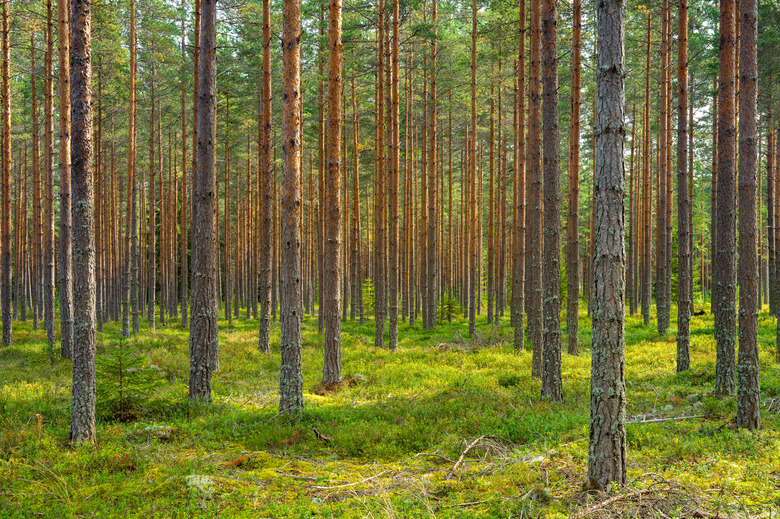The Average Height Of Pine Trees
With between 105 and 124 species of pine trees (Pinus spp.) growing in the Northern Hemisphere, finding an average size is dependent on the species and its growing terrain. The smallest pine reaches 5 feet tall, while the largest can top out at over 200 feet. The density of the forest in which the pine grows is another factor as sunlight is vital to the tree's growth. Select a pine tree for your landscape by familiarizing yourself with the different species and their growth patterns and coordinating it with your U.S. Department of Agriculture plant hardiness zone, anywhere between 2 and 10.
Defining a Pine Tree
Defining a Pine Tree
For a tree to be considered a pine tree, it must be a part of the genus Pinus. Firs (Abies spp.) and spruces (Picea spp.), while looking like a pine tree, belong to other genera. And with the wildly varying range of heights, no one species is ideal for all landscapes. The pine tree is resilient and tolerates almost any growing conditions, and many are found on top of hills or mountain ranges as they're excellent for erosion control. They also don't burn easily.
Shortest Pine Trees
Shortest Pine Trees
The little mugo pine (Pinus mugo var. pumilio, USDA zones 2-9) is prized as a bonsai plant, and its average height ranges from 4 to 6 feet. Originally found in the Alpine regions of Europe, the mugo pine (Pinus mugo, zones 2-8) favors higher altitudes and cool summer climates. At maturity, it can reach up to 20 feet, growing less than a foot a year. Growing low to the ground, both these specimens hide from fierce winter winds often experienced in high mountain ranges.
Mid-Range Pine Trees
Mid-Range Pine Trees
When choosing a pine tree for your landscaping, know that they lose lower branches as they grow and their roots penetrate the soil surface making it difficult to fill in the empty under space with other vegetation. The red pine (Pinus resinosa, zones 2-5) grows between 50 and 80 feet and has needles that grow in clusters of two. A warmer climate has good growing conditions for the gray pine (Pinus sabiniana, zones 8-9) with its gray needles grown in clusters of three. Found in the foothills, it averages 60 to 70 feet tall.
The loblolly pine (Pinus taeda, zones 6-9) is fast growing and is the mainstay tree for the lumber and paper industry. Found mainly in low, swampy areas, the loblolly reaches 60 to 90 feet at maturity. Pinyon pines (Pinus edulis, zones 4-8) are medium-growth pine trees (to 35 feet), which are a bushy relative that's adaptable to either hot or cold temperatures. Smaller versions are sold as holiday trees.
Whitebark pines (Pinus albicaulis, zones 2-8) are the trees you see at the highest elevations in the mountains. Needle clusters number five in each and the tree grows upward of 65 feet. It's an endangered species.
Tallest Pine Trees
Tallest Pine Trees
Located along the Rogue River in Southwest Oregon is the tallest pine tree measured. Known as the "Phalanx," the ponderosa pine (Pinus ponderosa, zones 5-9) was measured by hand at 268.3 feet tall, according to the U.S. Department of Agriculture, and is surrounded by others nearly that height. Nearby in the Umpqua National Forest is the tallest recorded sugar pine (Pinus lambertiana, zones 6-8), which measures 255 feet.
References
- Basic Biology: Pine Trees
- U.S. Department of Agriculture: Oregon Forest Home for World's Tallest Living Pine Tree
- Missouri Botanical Garden: Pinus mugo
- Missouri Botanical Garden: Pinus mugo var. pumilio
- Missouri Botanical Garden: Pinus resinosa
- Cal Poly Urban Forest Ecosystems Institute: Gray Pine: Pinus sabiniana
- Cal Poly Urban Forest Ecosystems Institute: Loblolly Pine: Pinus taeda
- Cal Poly Urban Forest Ecosystems Institute: Pinyon Pine: Pinus edulis
- American Conifer Society: Pinus Genus (Pine)
- American Conifer Society: Pinus albicaulis
